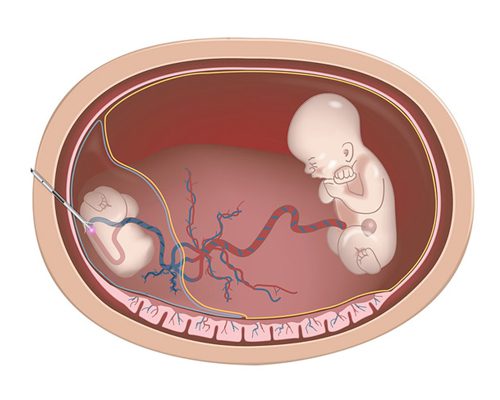Contents
Complications of triple and especially quadruple or more pregnancies are frequent, both maternal-fetal and neonatal. The medical side is not the only concern. Multiple pregnancies also cause disturbances within the family, which is not necessarily prepared psychologically, socially or financially, to welcome three, four or… six babies simultaneously. To overcome these difficulties, there is a solution, embryonic reduction. This medical technique aims to only allow a maximum of two fetuses to develop in the uterus by eliminating excess embryos.
Embryo reduction: who is affected?
The development of ART has led to an increase in the number of multiple pregnancies. But expecting three or four children at the same time is not without risk for the mother and the fetuses. An embryonic reduction can then be offered to the parents.
No law yet regulates embryo reduction. Its reasons are different from those of a “classic” voluntary termination of pregnancy, but it takes place within the same time limits as those authorized by the law on abortion. Thus, it does not require a specific procedure. However, as before any medical act, the couple receives detailed information on the technique and has a period of reflection before giving their written consent. THEa reduction is generally offered to parents, but it is also sometimes requested by couples who are already parents who do not feel ready, for example, to assume a triple pregnancy. However, not all multiple pregnancies (> 3) are reduced because a certain number of parents (around 50%) prefer to let them progress spontaneously.
Pregnancies affected by embryo reduction
Apart from a serious medical problem in the mother, twin pregnancies are not affected by embryonic reduction. This medical act is mainly offered when the pregnancy has more than three embryos. In addition to maternal complications more frequent in these pregnancies, it is especially the risk of very prematurity which takes precedence in the decision. For triple pregnancies, the problem is more ambiguous because advances in perinatal medicine have markedly improved the vital prognosis of premature triplets. In this case, it is more family and psychosocial arguments that determine the indication of the gesture.
Embryo reduction, a rare gesture
Embryo reduction is a medical procedure which remains rare in France and which continues to decrease for ten years, thanks to measures taken by centers practicing medically assisted procreation (PMA). The number of embryos transferred after in vitro fertilization is now two, which limits the occurrence of multiple pregnancies greater than three. Likewise, after stimulation of ovulation, hormonal assays and ultrasounds performed regularly prevent the appearance of an excessive number of follicles. Unfortunately, from time to time, nature takes over, and three or even four embryos develop, putting parents and the obstetric team before a difficult decision.
Embryo reduction in practice
What technique do we use?
The most common attitude is to reduce the number of embryos to two. Depending on the age of pregnancy, two methods are practiced, always guided by an ultrasound. The most common is to pass through the maternal abdominal route (a bit like during an amniocentesis) around 11 weeks of amenorrhea (AS). A needle is introduced to the thorax of one (or more) embryo (s) then products are injected first to put the embryo to sleep, then to stop cardiac activity. Rest assured, the embryos are not in pain, as the heart stops beating within seconds. The embryos are not chosen at random but on different criteria. The rarest, such as the existence of a malformation or the suspicion of a chromosomal anomaly, allow a first selection. The doctor then looks carefully at the number of placentas and water pockets. Finally, he “chooses” the embryos according to their accessibility and their position in relation to the cervix. The second technique, less used, passes by the transvaginal route and takes place around 8 weeks.
Embryo reduction: how the operation works
No long hospitalization, since the reduction takes place in a day hospital. You don’t need to be fasting because no anesthesia is needed. Rest assured, the needle used is very fine and you will only feel a very small bite, no more unpleasant than that of a mosquito. The actual procedure is always preceded by an in-depth ultrasound which allows the location of the embryos. The duration of the act is variable. It depends on the technical conditions (number, position of embryos, etc.), on the patient (morphology, feelings, etc.) and on the operator’s experience. To avoid infection, antibiotic treatment is essential. The uterus, meanwhile, is put to rest with antispasmodics. Once the gesture is completed, the patient remains under surveillance for an hour before being able to return home. Twenty-four hours later, a follow-up ultrasound is performed to check the vitality of the preserved twins and the absence of cardiac activity in the reduced embryos.
Are there any risks associated with embryo reduction?
The main complication of embryonic reduction is spontaneous miscarriage (in about 4% of cases with the most used technique). Generally, it occurs after an infection in the placenta (chorioamnionitis) some time after the gesture. Fortunately for the majority of expectant mothers, pregnancy continues normally. However, statistics show that prematurity is greater than in spontaneous single or twin pregnancies, this is why mothers need more rest and are stopped throughout the pregnancy.
What about the shrink side?
The psychological impact of such a gesture is significant. Reduction is often experienced as a traumatic and painful experience by the couple and they need the support of the whole team to deal with it. Parents have mixed feelings, mainly due to the fact that the reduction most often occurs after infertility treatment. The relief of having a safer pregnancy often gives way to guilt over having to part with non-diseased embryos. For expectant mothers, carrying both these “dead” embryos and living fetuses can also be difficult.










